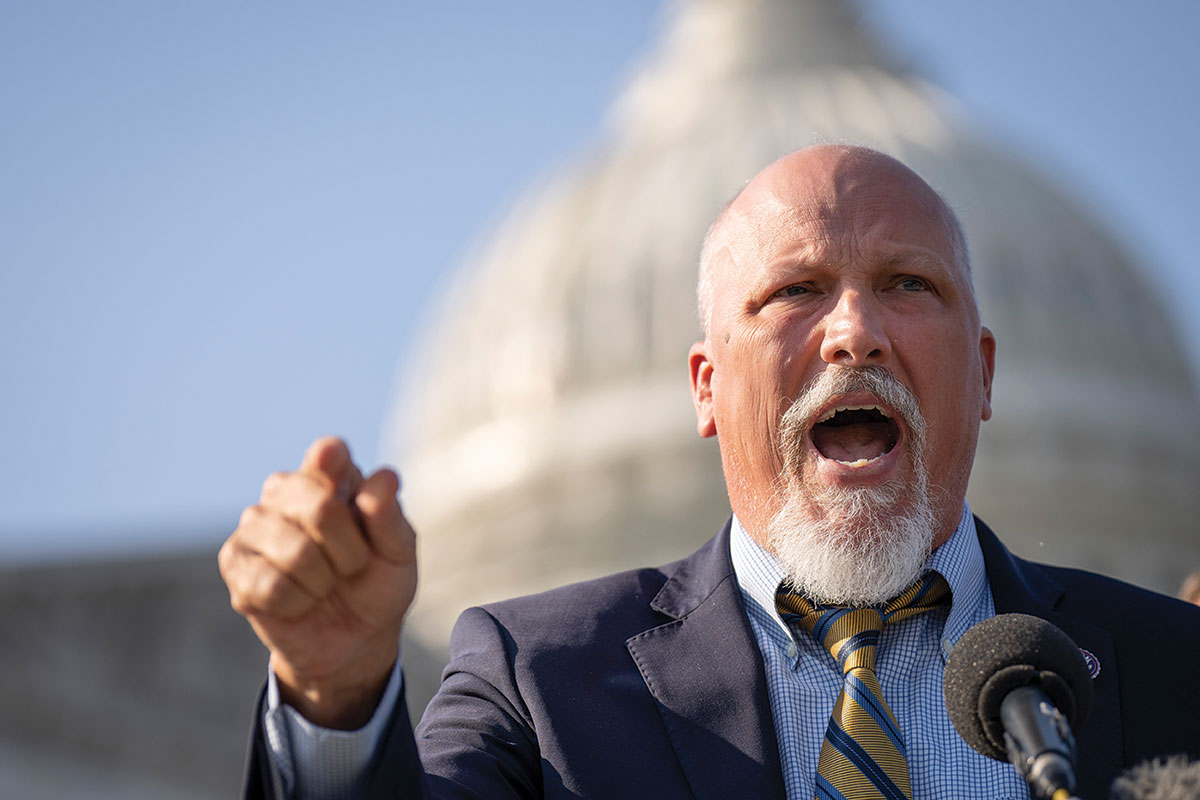The Disturbing World of the New GOP
The Nationals #TheNationals


Illustration by Victor Juhasz.
Subscribe to The Nation Subscribe now for as little as $2 a month!
Thank you for signing up for The Nation’s weekly newsletter.
Thank you for signing up. For more from The Nation, check out our latest issue. Subscribe to The Nation Subscribe now for as little as $2 a month! Support Progressive Journalism The Nation is reader supported: Chip in $10 or more to help us continue to write about the issues that matter. Sign up for our Wine Club today. Did you know you can support The Nation by drinking wine?
The Republican Party that will take narrow control of the House of Representatives in January 2023 has gone through a dramatic transformation in the two years since Donald Trump and his allies attempted a violent coup to overturn the results of the 2020 presidential election. The party that was once torn over how to respond to Trump’s assault on democratic norms is no more. It was replaced in 2022 by one that did not merely tolerate Trump’s election denialism but embraced it by nominating January 6 insurrectionists and apologists for congressional and statewide posts—a strategy so noxious that it cost Republicans key US Senate contests and the “red wave” GOP strategists were counting on. But postelection pundits who imagine that the party will do an about-face and suddenly adopt a more politically rational course are sorely mistaken. The new Republican Party has a base—and many leaders—that does not merely fall for Trump’s lies. Republican partisans are increasingly looking beyond the scandal-plagued former president and taking inspiration from right-wing European nationalist leaders with politics rooted in a fascist sensibility that employs racism, xenophobia, and a win-at-any-cost approach to elections and governing. This transformed Republican Party will exploit its control of the House and state posts for a 2024 presidential election in which Trump and a rising generation of ruthless partisans will plot a return to unitary power—with a vision that is dramatically more authoritarian than anything seen in the 45th president’s first term.1
This is something Democrats need to recognize as they prepare for this next political moment. They won’t be governing with a political party that realistically compares with the very conservative yet still institutionally inclined caucuses that controlled the House on and off between 1995 and 2019. In 2022, the GOP moved past its “semi-fascist” stage and began “barreling toward full-on fascism,” says former US representative Joe Walsh, who was considered among the most right-wing members of the House after his election in the Tea Party wave of 2010. “The country needs to understand that my former political party is fully anti-democracy. It is a fascist political party. It is a political party that embraces authoritarianism,” as evidenced by Republicans at the 2022 Conservative Political Action Conference (CPAC) celebrating European nationalists and domestic insurrectionists. “We’ve got to move on now and just defeat them.”2
A lot of Republicans were defeated on November 8. But the party still won the power, via its new House majority, to derail much of President Biden’s agenda. Incoming House Speaker Kevin McCarthy’s Republicans did not gain as many seats as they might have achieved as a more conventional, institutionally inclined Grand Old Party running in a more traditional midterm election. But they succeeded in melding concerns about inflation and crime, racial backlash messaging, and a fiercely negative and immensely well-funded campaign to secure victories that should have been unimaginable. In part, this was because America’s rigid two-party system forces an either-or choice on most voters. Such a system creates a situation in which the right can exploit economic and social anxiety to attract voters who don’t necessarily agree with the whole GOP agenda but who want to—in the parlance of former Alabama governor George Wallace’s racist campaigns—“send them a message.”3
The message this time is a daunting one, because the party that surfed a wave of resentment over high gas prices and post-pandemic instability is not the GOP of Ronald Reagan, the George Bushes, or Dick Cheney. None of those figures would have stood a chance in the Republican primaries of 2022. Indeed, Liz Cheney, the standard-bearer of the social and economic domestic conservatism and foreign policy neoconservatism that held sway until Trump came along, won just 28.9 percent of the vote in her Wyoming Republican primary reelection bid.4
There is no question that the Republican Party began veering dangerously to the right long before the 2022 midterm election season. This is, after all, the party that welcomed Southern segregationist Strom Thurmond into its ranks during Barry Goldwater’s 1964 “extremism in the defense of liberty” presidential campaign. But as I watched the 2022 races play out in states across the country, it was clear to me, and to many other longtime observers of the GOP with whom I spoke, that it’s taken a far more dire turn. This Republican Party is proudly unapologetic about its excesses; there is an open acceptance that “we’re doing bad things and we don’t care because we think it will work politically.”5
The determination that we saw in the none-too-distant past to maintain a veneer of respectability—with admittedly disingenuous efforts to push back against accusations that the party was running overtly racist, crudely xenophobic, and aggressively dishonest campaigns—has been abandoned. As has any willingness to acknowledge that particular candidates, such as the Georgia US Senate nominee Herschel Walker or the newly elected Ohio Senator J.D. Vance, are too toxic to be supported. Thus completes the GOP’s devolution into a party that has fully abandoned its conscience.6
Current Issue
Whether the party is described as authoritarian, neofascist, or fascist, the trajectory is clear. “Trump had done everything he could to seize the laurel crown and declare himself an American Caesar,” says Sarah Churchwell, one of the great scholars of American fascism. “He hasn’t given up yet—and, what is more, neither have most of his supporters.” Even as the 2022 results pointed to dozens of races in which Trump’s interventions had saddled the GOP with weak candidates—who in many cases lost what should have been winnable seats—Republican leaders on Capitol Hill, such as House Republican Conference chair Elise Stefanik, rushed to endorse the 2024 presidential bid he announced in mid-November. And while the same pundits who imagined that Trump would be rejected by Republicans in 2015 and 2016 are now sure that Florida’s Ron DeSantis has the juice to snatch the nomination from Trump, polls still show Republicans favoring the former president by a wide margin over the governor he decries as “Ron DeSanctimonious.” The mistake the pundits are making is to imagine that most Republicans are eager to move beyond the crude hatemongering that has characterized that party since Trump banished talk of “the big tent” and started describing anti-Semitic white nationalists as “very fine people.”7
Today’s Republican Party gleefully amplifies the language of its once shunned but now broadly accepted ideological mentor, Steve Bannon, the connoisseur of European fascist literature and movements. It embraces an ideology that promises not just retribution for political rivals—and for longtime targets of its vitriol, such as Dr. Anthony Fauci and the liberal philanthropist George Soros—but a wholesale restructuring of federal power.8

A rising star in the House Republican Conference, Texas Representative Chip Roy outlined a strategy to make Joe Biden a lame-duck president. (Drew Angerer / Getty Images)
Even with a narrow majority, a Republican-controlled House will immediately stop exercising its oversight powers to get to the bottom of Trump’s coup attempt and will begin attacking the January 6 committee’s investigators and the very notion of accountability. That will be only the beginning of a campaign to make Joe Biden a lame-duck president by rejecting his policy proposals and weaponizing the budget process to deny funding to federal agencies. Outlined in a September “Dear Colleague” letter from Texas Representative Chip Roy, an emerging force within the House Republican Conference, the strategy would reject continuing resolutions in order to block “tyrannical government agencies, offices, programs, and policies that Congress regularly funds through annual appropriations bills.” The theory is that the ensuing chaos will convince voters that only a switch to full Republican power will make the wheels of government turn once more.9
If and when Republicans gain control of all three branches of the federal government, they will execute their explicit mission to politicize the government along the lines Bannon has laid out. In his War Room radio show and podcast, the veteran Trump whisperer amplifies the messages of the former president’s congressional coconspirators, election deniers, and extremist rising stars, promising that his reelection in 2024 will put “4,000 shock troops” in charge of reconstructing the federal government as a battering ram for right-wing ambition.10
Bannon is not alone in applying the language of fascism to the Republican Party. This is a party that now openly courts European right-wing extremists. Remember that, along with Hungarian strongman Viktor Orbán, one of the stars of the 2022 Conservative Political Action Conference was the Italian politician Giorgia Meloni, the leader of a party that traces its political lineage to the neofascist movement that emerged from the wreckage of Benito Mussolini’s World War II alliance with Nazi Germany. Meloni is now Italy’s prime minister, a political ascent Texas Senator Ted Cruz hailed as “spectacular.” Fox News gushes over her election as “the dawn of a new day.”11
But, of course, as the title of Sinclair Lewis’s 1935 dystopian novel about the threat of fascism in America suggested, it can’t happen here.12
Or can it?13
After Meloni’s Brothers of Italy Party led the voting there in September, CPAC’s chairman, Matt Schlapp, told Bannon that the party “fits right neatly in the term of what we call ‘conservatives’ here in America.”14

Marjorie Taylor Greene used to be an outlier in Congress. Today, very few of her positions put her at odds with the Republican Party’s base. (Emily Elconin / Getty Images)
The 2022 campaign season saw Republican elected officials such as Florida state Representative Anthony Sabatini unapologetically tweet quotes from Francisco Franco, the fascist dictator of Spain, and proclaim in a speech, “God bless the nationalist populist movement,” and US Representative Marjorie Taylor Greene, an increasingly influential figure in a House Republican Conference that once decried her extremism, declare her loyalty to the racist doctrine of Christian nationalism, which would shred the US Constitution to eliminate the separation of church and state. Lest anyone dismiss the Georgia congresswoman as a fringe figure, a poll released earlier this year revealed that 61 percent of Republicans shared her sympathy for Christian nationalism. In fact, very few of Greene’s positions put her at odds with the party’s base. That’s certainly the case with her agitation in support of Trump’s election denialism; according to a September YouGov poll, only 43 percent of Republicans said candidates who lose elections should concede defeat.15
Less than two years ago, when Liz Cheney was still the No. 3 Republican in the House, Greene was an outlier there. Now Kevin McCarthy is promising to restore the committee assignments that Greene was stripped of after a CNN investigation found that she had repeatedly expressed support for executing prominent Democrats. Greene, a Republican favorite who is talked about as a potential running mate for Trump in 2024, meets with McCarthy on a regular basis and said in October that, “to be the best speaker of the House and to please the base, he is going to give me a lot of power and a lot of leeway.” This from a woman who during the 2022 campaign compared her political rivals to feral hogs and then posed with a dead animal she had just shot from a helicopter.16
“What you first act out through make-believe you can later make reality. That final step, that step from play-acting to acting, is much less daunting once you’ve had sufficient rehearsal, which is what we’re witnessing,” wrote the Georgia journalist Jay Bookman in a reflection on Greene’s none-too-subtle talk of hunting down Democrats. Comparing Greene to the dangerous “true believer” of the post–World War II era that the philosopher Eric Hoffer wrote about, Bookman observed, “Greene is such a fanatic, as are many others in the rising New Right who are riding racism and hatred and fear, who hint openly at the necessity for violence if the change they seek cannot be produced through the ballot box. Speaking personally, I am not ready to see this world with all its shortcomings come to a sudden end. But such fires, once ignited, can be difficult to suppress.”17
Bookman was not alone during the run-up to the midterms in recognizing a turn on the part of the GOP toward a more overt and threatening extremism than had been seen before. Where there had once been robust debate within the party about Trump’s actions, the dissenters are gone—retired in the case of former House speaker Paul Ryan and traditional inside-the-Beltway conservatives; defeated in the case of Cheney and others who defied Trump after the January 6 attack on the Capitol; and dragooned into submission in the case of party hacks like McCarthy who do not want to lose their positions. “The intimidation actually works. We’ve seen this before in democratic societies,” said Miles Taylor, a former Trump administration official. “You know where we’ve seen it. We’ve seen it in the Weimar Republic in Germany, before the rise of Hitler. It’s not hyperbole to draw those comparisons, because we saw very similar behavior happening that was founded on, guess what, on a big lie. On a big political lie that led to that type of violence.” Matthew Dowd, a former senior adviser to the Republican National Committee who served as chief strategist for George W. Bush’s reelection campaign, said just weeks before the midterms, “I’ll remind people, too, of a history lesson that in 1930s Germany, there was a candidate and there was a party that said they were going to do something about inflation. And they did something about inflation. Inflation went away, but so did the democracy in Germany in the 1930s up until 1945.”18
Dowd was a little shaky on his economic history. Germany’s period of hyperinflation was in the early 1920s; by the early 1930s, the issue was mass unemployment. But his point about economic instability creating an opening for fascism is well understood by anyone who has studied the era. So, too, are the tactics of contemporary Republicans who have brought a new level of sophistication to the age-old strategy of employing anti-immigrant and racist tropes to demonize opponents. In 2022, this form of campaigning was everywhere.19
“They’re out–Willie Hortoning the Willie Horton ads,” Minnesota Attorney General Keith Ellison told me in October, referring to the crude “soft on crime” ads George H.W. Bush used to attack Democratic candidate Michael Dukakis in the 1988 presidential election, which were once considered the lowest form of racialized campaigning. Locked in a tight reelection race that he ultimately won by around 20,000 votes, Ellison, who is Black and was the first Muslim elected to Congress, and who had organized the successful prosecution of the police officer who murdered George Floyd, faced an onslaught of such commercials. “Keith Ellison’s been anti-cop forever,” declared the ads. The images of violent crimes that flashed on the screen with shadowy pictures of Ellison were, in many cases, more than a decade old—from before he was elected attorney general—and from as far away as Florida. What sleazy group paid for the deliberately dishonest and inflammatory ads? The corporate-funded Republican Attorneys General Association, which had raised more than $26 million for attack ads by mid-October.20
In neighboring Wisconsin, mailings from the state Republican Party included images of the Democratic US Senate candidate Mandela Barnes with his skin clearly darkened. TV ads labeled Barnes, the first African American to serve as the state’s lieutenant governor, as “different” and “dangerous,” while the National Republican Senatorial Committee poured almost $3 million into incendiary commercials that interspersed images of Barnes with crime scenes and messages repeating a bogus claim that he wants to release 50 percent of the state’s prison population immediately. “As if Barnes told people to create crime, which is ridiculous,” said Calena Roberts, the Wisconsin field director for the Service Employees International Union, who participated in a “Pull the Racist Ads” protest outside the office of the incumbent in the race, Republican Senator Ron Johnson. “Then they used his picture—they’re changing the color of his skin. You use the original photo, then you darken it up. It’s all about race.” (Barnes lost by around 26,000 votes, out of 2.6 million cast.)21
Related Article
It was all about race, and it was everywhere in the 2022 campaign. Republicans ran racist and xenophobic ads without apology—and without any accountability for the billionaire donors and corporate interests that funded them. Indeed, suggested Joe Walsh, they did so gleefully. “I hear it from them every day. Where it used to be ‘We have to do things untoward to defeat Dems,’ now it’s ‘Fuck, yes, let’s do dirty, bad, illegal shit. Who cares? It’ll help us win.’” And it’s not just Republican operatives saying it; it’s Republican donors who long ago made their peace with Trump and Trumpism. They may prefer their strongmen to wear suits and ties, as DeSantis does, but they’ll accept tax cuts from anyone.22

Win at any cost: Republican partisans rallied behind Herschel Walker, no matter how big the crisis surrounding the candidate. (Elijah Nouvelage / Getty Images)
When a candidate stumbles badly, even when revelations about that candidate’s past point to jaw-dropping hypocrisy, the win-at-any-cost mentality kicks in. That’s what happened when Herschel Walker’s Georgia Senate campaign was rocked by the news that the anti-choice candidate had paid for at least one abortion. Walker compounded the crisis by lying about it. But none of that seemed to matter. Religious right leaders rallied with Walker. Dana Loesch, a former spokesperson for the National Rifle Association who remains a key conservative influencer, declared, “It doesn’t change anything for me.”23
“I don’t care if Herschel Walker paid to abort endangered baby eagles,” Loesch said. “I want control of the Senate.”24
Winning has always been the point of electoral politics. And racist appeals are nothing new. But when a win-at-any-cost strategy is systematically implemented, not by rogue candidates or consultants but by political operations that are overseen by party leaders in the Senate and funded by the wealthiest individuals and corporate interests in the United States, that’s a strategy. And it’s common in autocratic movements.25
MORE FROM John Nichols
“This political movement is supported by a minority of people in the country,” explained Steve Schmidt, a former presidential campaign strategist for John McCain. “But that minority controls all of the institutions and the levers of power at the local, county, state, national levels of one of the two political parties. So a minority movement filled with extremists that wants political power sees a route to achieving it through a majority election that cloaks the minority extremist cause. You have some people who look at what’s happened with Herschel Walker and say, ‘It doesn’t matter at all, because he’s a vessel by which we can ride to power.’ And in this case, increasingly, the inference is ‘Once we’re in there, we’re not giving it up.’”26
Schmidt is honest about the fact that he and others like him played a role in the transformation of the Republican Party—not least with McCain’s decision to make former Alaska governor Sarah Palin his vice presidential nominee in the 2008 campaign. But Schmidt has since been sounding the alarm bells with a passion that exceeds that of many Democrats. When we spoke during the 2022 campaign about today’s GOP, he warned about “all of the elements that have to come together for an autocratic movement.”27
“What do you need to have a cult of personality? Right away, you need two things: You need charismatic leaders, and you need followers. But that’s not enough,” Schmidt said. “You need financiers. You need the billionaire class…. You need the propagandists. You need the cynicism of the elites…. When you put all that together in a coalition for power, history teaches us that things can go off the rails, that evil can be committed.28
“We’re in this moment of profound gaslighting, insanity,” Schmidt added. “And there is a lack of a focused, fierce, oppositional better message.”29

Donald Trump and Republican partisans are plotting a return to power with a vision more authoritarian than anything seen in his first term. (Joe Raedle / Getty Images)
So what will the oppositional message be? It has to involve more than the Democratic Party tripping over its own messaging and stumbling over its own strategies, which we saw frequently in 2022. Against some of the worst Republican candidates in history, Democratic candidates still couldn’t thread the needle. And they won’t do so going forward if they avoid the reality of the Republican Party’s devolution.30
“Two of the hallmarks of a fascist political party are: One, they don’t accept the results of elections that don’t go their way. And two, they embrace political violence,” Representative Jamie Raskin reminded us in September. He was talking about the January 6 attack on the Capitol. But less than two months after Raskin expressed his concerns, Trump and other prominent Republicans were peddling conspiracy theories about the attack on Paul Pelosi, the husband of House Speaker Nancy Pelosi, in their home.31
Democrats need to be prepared to discuss the devolution of the Republican Party, just as they need to ask themselves: “What are the hallmarks of an anti-fascist party?”32
The party must be prepared to speak—as former vice president Henry Wallace did almost 80 years ago—about “the danger of American fascism.” And it must be about the business of addressing the economic, social, and racial injustices of the moment, not merely because it is the right thing to do morally but because it is the right thing to do politically. This was clearly illustrated by John Fetterman’s successful run in Pennsylvania, which turned out to be the only Democratic bid this year that flipped a Republican-held seat in the Senate.33
Democrats and their allies need to start framing the fight in broader, more idealistic, and more hopeful terms. They did better than expected in 2022, as voters in many states rejected election deniers and win-at-any-cost Republicans. They can do better still in 2024 by refusing to compromise with extremists and by calling out the corporate and media elites who give aid and comfort to authoritarians. They must proudly assert the rule of law in official quarters. But they must also mobilize across the lines of race, ethnicity, gender, and class for a bolder vision of the America that must be.34
We’ve been too weak in our enthusiasm for democracy, too slow to recognize that Wallace was right when he wrote, “Democracy to crush fascism internally must demonstrate its capacity to ‘make the trains run on time.’ It must develop the ability to keep people fully employed and at the same time balance the budget. It must put human beings first and dollars second. It must appeal to reason and decency and not to violence and deceit. We must not tolerate oppressive government or industrial oligarchy in the form of monopolies and cartels. As long as scientific research and inventive ingenuity outrun our ability to devise social mechanisms to raise the living standards of the people, we may expect the liberal potential of the United States to increase. If this liberal potential is properly channeled, we may expect the area of freedom of the United States to increase. The problem is to speed up our rate of social invention in the service of the welfare of all the people.”35
The hour is late. But the authoritarians who now steer the Republican Party and those who compromise with them are a minority in our politics—as the results on November 8 confirmed. Thanks to gerrymandering and billionaire money, they now have control of the House. But it is not fated that they will take charge in 2024. The pro-democracy majority has been too confident in the belief that it can’t happen here. Now that majority must rise up and declare it won’t happen here.36